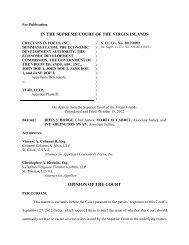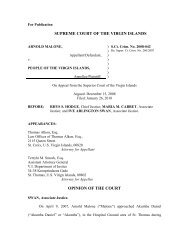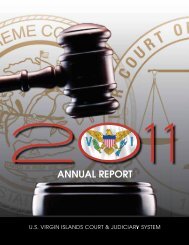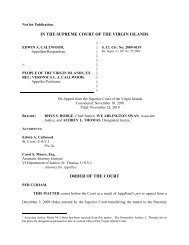IN THE SUPREME COURT OF THE VIRGIN ISLANDS OPINION OF ...
IN THE SUPREME COURT OF THE VIRGIN ISLANDS OPINION OF ...
IN THE SUPREME COURT OF THE VIRGIN ISLANDS OPINION OF ...
Create successful ePaper yourself
Turn your PDF publications into a flip-book with our unique Google optimized e-Paper software.
Watts v. Two Plus Two, Inc.S.Ct. Civ. No. 2007-127Concurring OpinionPage 16 of 23‘history of dilatoriness.’” Id. at 261 (citing Scarborough v. Eubanks, 747 F.2d 871, 875(3d Cir. 1984)).Appellee’s Motion to Dismiss for Failure to Prosecute, because of Appellant’sfailure to comply with court ordered deadlines, was premature. Most of the deadline datesin the trial court’s February 15, 2007 Scheduling Order had not arrived as of July 16, 2007,the date Appellees filed their Motion to Dismiss for Failure to Prosecute. Importantly,factual discovery was due on May 25, 2007, and both Appellant and Appellees failed tocomply with this aspect of the February 15, 2007 Scheduling Order. Appellant’s expertdisclosures were due on June 27, 2007, but Appellant filed his disclosures one month later.Significantly, when Appellees filed their Motion to Dismiss for Failure to Prosecute on July16, 2007, there were five outstanding deadline dates in the trial court’s Scheduling Orderwhich had not expired. The outstanding deadline dates included a deadline for Appellees’expert disclosures due on July 27, 2007, a deadline for expert depositions on August 24,2007 and a deadline for dispositive motions on September 7, 2007. This case is unlikeOrdnance Guage Co. v. Jacquard Knitting Machine Co., Inc., 265 F.2d 189, 195 (3d Cir.1959), wherein the Third Circuit concluded, with certainty, that the trial court was correctin finding there was a failure to prosecute a case which had lay dormant for over five years.Admittedly, Appellant was dilatory in moving this case towards a final resolution,since filing his Complaint on May 28, 2003. However, when the trial court entered itsFebruary 15, 2007 Scheduling Order, which included deadline dates for discovery, adeadline for mediation, a calendar call date, and a trial date, the Scheduling Order appearsto have nullified the parties’ prior dilatoriness and re-commenced all discovery dates.Moreover, the trial court’s Scheduling Order is calculated to comply with the trial court’s
















